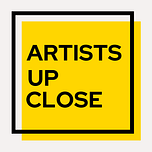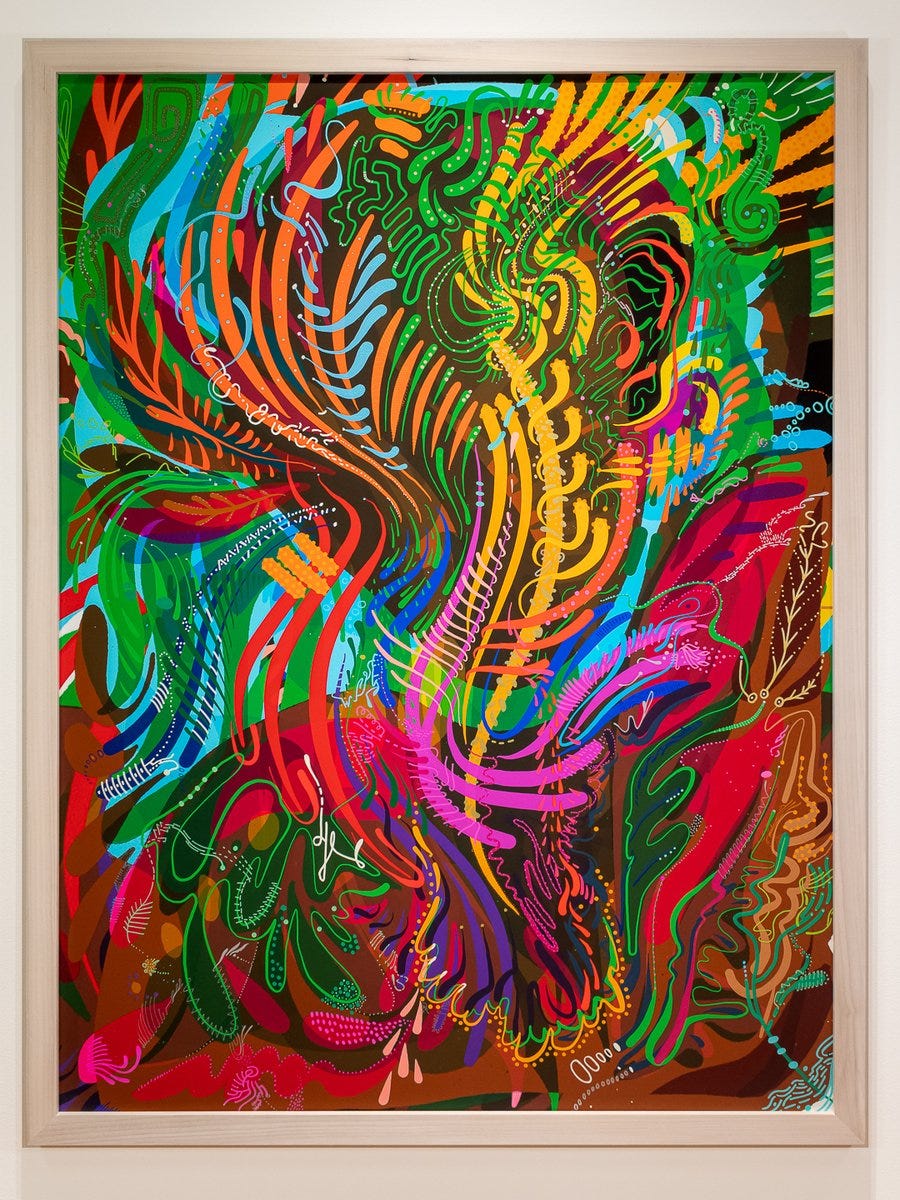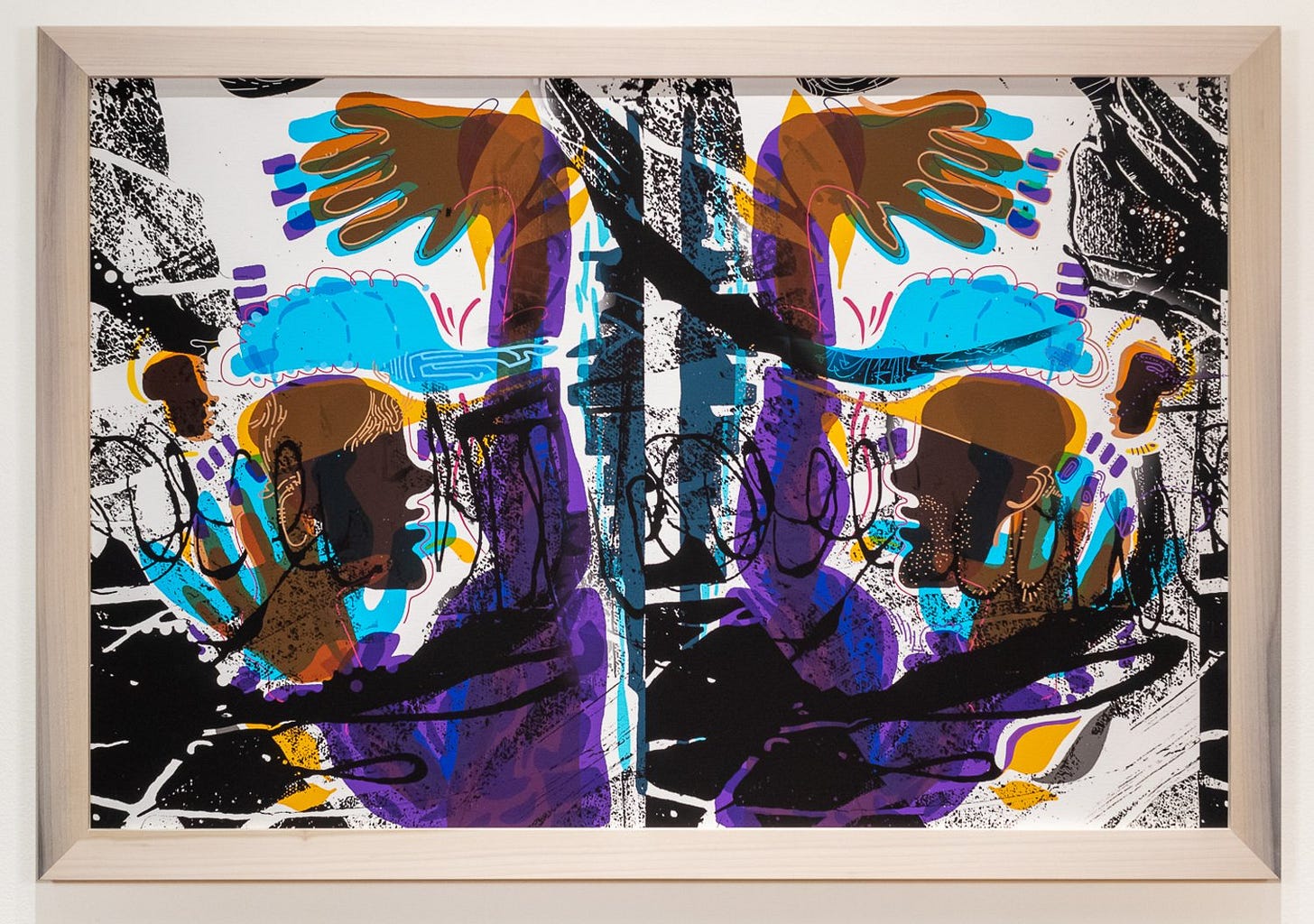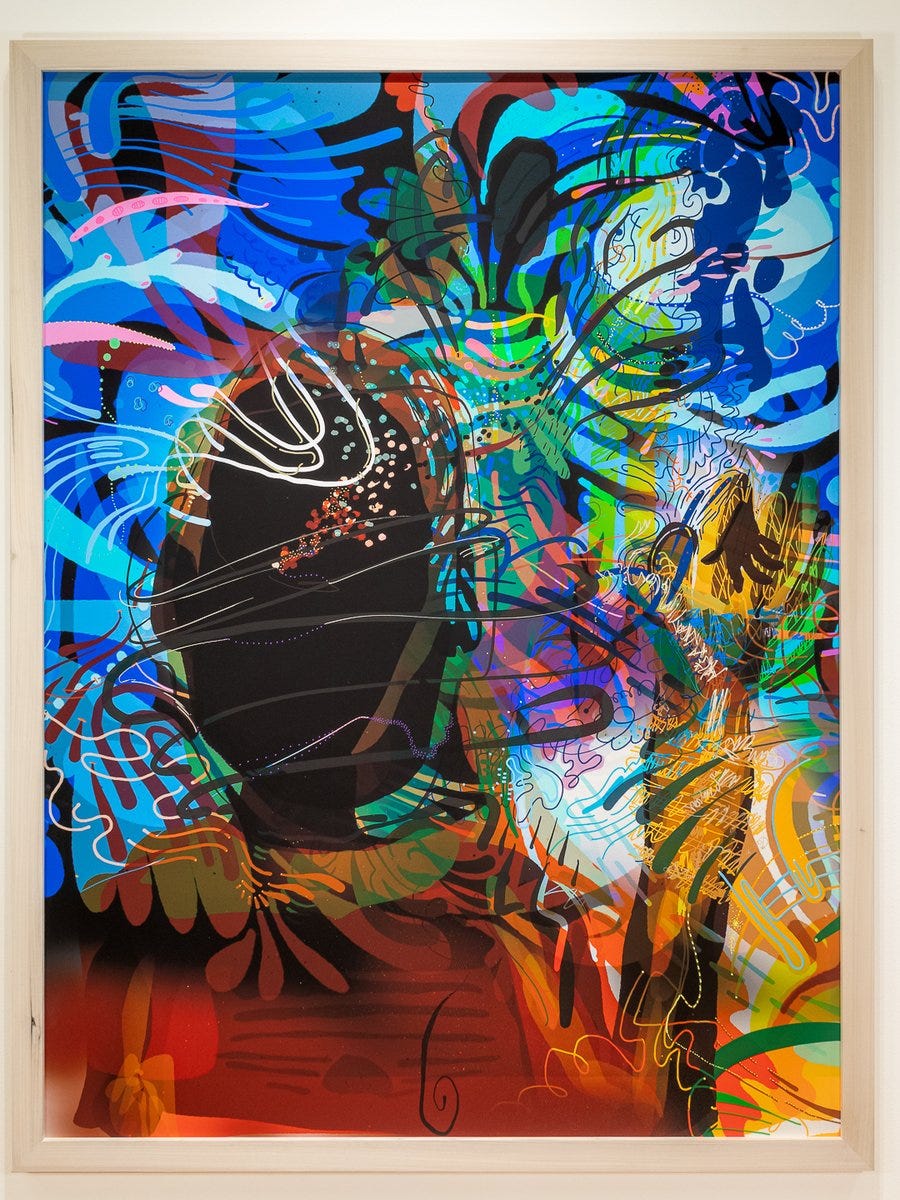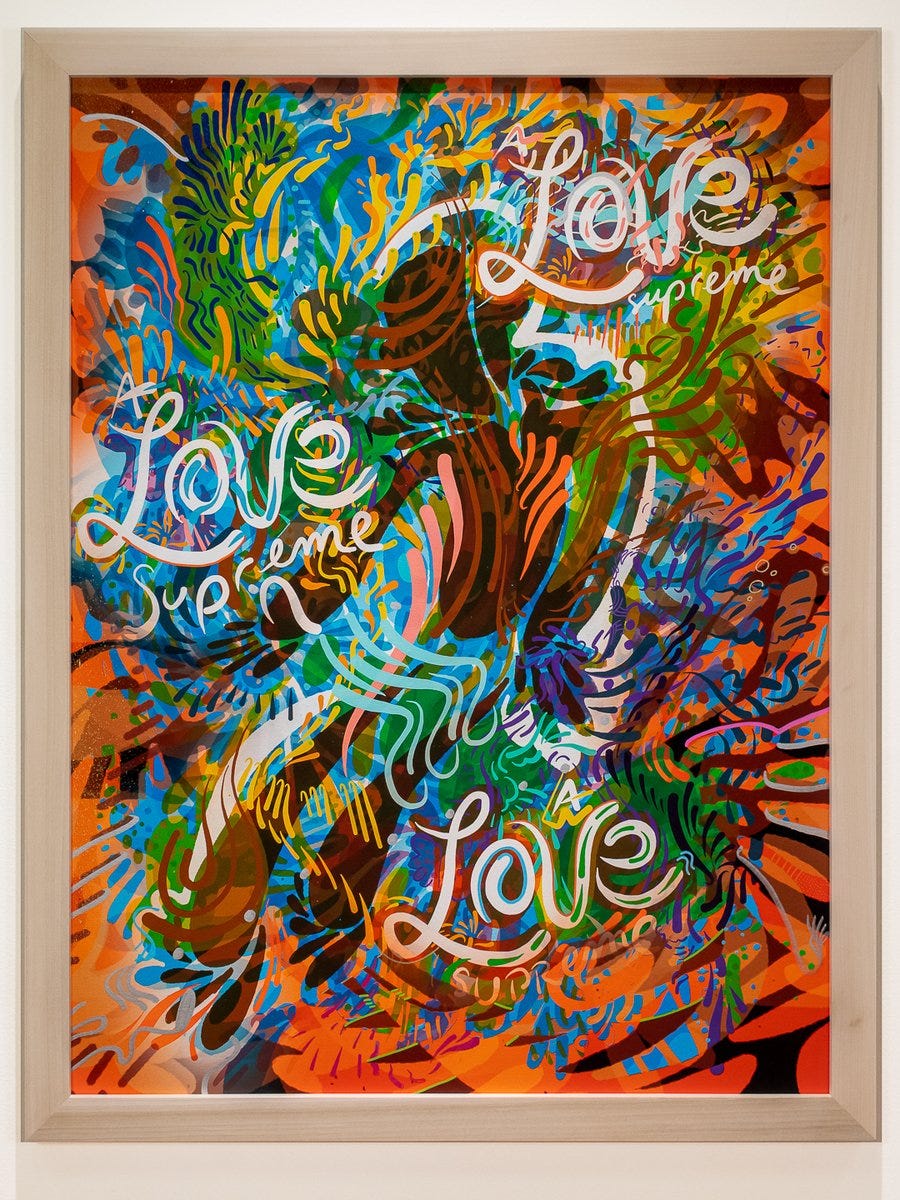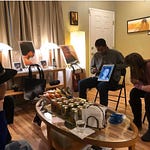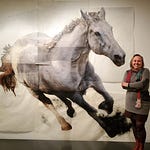“I'm a closet anthropologist,” said Moses Sun, a Seattle-based visual artist who shared his artistic journey with Artists Up Close in a telephone interview. “I study people. I study the cities. I study everything, like constantly, my brain is constantly just gathering information.” Born and raised in Fayetteville, North Carolina, Sun grew up in a family committed to community — his mother taught at a school that served students living at and below the poverty line while his father worked as a counselor at a local community college. And it was his father’s unconditional love and nonjudgmental way of engaging the world around him that shaped Sun’s outlook on life.
“That has allowed me to always have an open mindset and a really non-judgmental point of view,” Sun said. “I may meet somebody that makes me uncomfortable, someone that I may not be familiar with, or someone who may be doing something completely different or that's weird to me. But that doesn't lead to judgment, that only leads to observation and questions.”
I met Moses Sun at the 2022 Seattle Art Fair. I was eagerly taking in everything the fair had to offer when I noticed another artist whose work I deeply admire. Of course, I had to stop, fangirl, and try to convince her to let me cover her for Artists Up Close. And as I was trying my hardest to convince this other artist to let me interview her, someone else caught my attention: Moses Sun. He was standing right next to the other artist I was chatting up. “I’m an artist too,” he said. “You can interview me.” He was gentle, soft spoken, and I almost hadn’t noticed him at all. He gave me his contact details and the link to his portfolio, and I tossed it in with the rest of the postcards I had collected that day. But when I finally got around to sifting through all the marketing materials I had collected at the fair, I was particularly blown away by Sun’s craft and the sheer emotionality he conveyed with every brushstroke. I definitely had to interview him.
“Your degree, your money, your whatever, none of that stuff matters,” Moses Sun said during our interview. “It’s the human that you are. At the end of the day that’s always served me well. Just treat people as human first and whatever else second. Not that the world treats me that way.”
Before 2018, Sun had worked as a corporate creative while moonlighting as a fine artist in his off-hours. Over the course of more than a decade he had worked as a manager, creative director, a senior contributor, a freelancer and contractor. And while still in college, he had launched a video production company and would go on to work at Disney and ESPN. For him, it was all a learning experience — a way to gain a deep understanding of the business and get paid for it. At the beginning of his career, it was enjoyable for Sun to experience that dichotomy of being a fine artist (with total creative freedom) and being a corporate creative (with its limitations and requirements); but eventually the darker aspects of corporate America began to take its toll.
“I was hospitalized for exhaustion,” Sun said. “Because I was working a lot, I had a lot of things going on, and my body just broke down. … It was a very trying period of time for me. It was a combination of both physical and mental health issues that kind of came together all at one time.”
Sun remained hospitalized for 21 days, where he says that he felt isolated, unheard, and subjected to dangerous racialized assumptions and mythologies. And his latest body of work, 21 Chambers: A New Beginning (which was exhibited at the J. Rhinehart Gallery in September 2022) is inspired by his journey out of that dark experience.
“21 Chambers is an ongoing series that I started four years ago after being hospitalized for 21 days straight,” said Moses Sun, “not seeing my family and not really interacting with people outside of the hospital. … . And after I got out, I wasn't able to work, like a regular job. Actually, I wasn't able to work at all. So, I took two years off, because I knew it would take me about two years to recover. … And while being in the hospital was very hard for me —there's a lot of anxiety and separation and just kind of a dark period of time —I continued to draw and create while I was there. But once I got out, I was really just a shell of myself. And I made art about that experience, about the hard parts, about the real visceral— the sadness the depression, like all those types of things that happened. But then as I was making that work and, getting that out of my system, I realized: I was like, ‘wait a minute, if we continue down this road, it's just going to be, it's a very dark, dark road.’”
Sun said that he creates a lot of art about race and enslavement which, for him, can feel very heavy and painful. So, with the 21 Chambers series he wanted to create work that was more celebratory, hopeful, and healing.
“I really wanted to make— I challenged myself to make work about hope,” Sun said. “And through making work about hope, it helped me heal. And so, for two years, I was able to stay in my house (I'm renting from a friend), and just make art, like every day, literally I drew every day. I made paintings, drawings, collages. I even made assemblage pieces, sculptures. I just made whatever was on my mind, what was inside me. I just really became a vessel then of just all of these different things, or all these different things that were going on. So, 21 Chambers refers to the 21 days I was in the hospital. But 21 Chambers has now become more of a book of healing because there's 21 Chambers and there's 21 Chambers: Illumination. There's 21 Chambers: The Chrysalis, and now there's 21 Chambers: A New Beginning. So thematically, for me, it's a combination of like, what happens when you intersect with the healthcare industry, mental health or physical health, and then the fallout that comes from that. But then, taking all that energy, taking that experience and moving it into a place of meditation, and meditating on hope, meditating on despair, meditating on love, meditating on abandonment, meditations on friends, meditation on family, meditation on being a father. You know, having a daughter, being a parent, living, creating, destroying, letting go.”
Part of Sun’s process was letting go of old ways of being in the world and relating to his art practice. He went from straddling the corporate and fine art worlds to working as a full-time artist. But even that kind of language was something Sun questioned.
“I think even notions of full-time artists, for me, don't hit right,” said Sun. “Because it's very much a business language. I mean, your art studio is definitely a business, but the practice of being an artist doesn't align with nine-to-five. For me, being a creative, I'm always in a creative mode: If I'm cooking, I'm in creative mode. If I'm writing, I'm in a creative mode. Even if I'm just exploring the city or whatever, it’s from a creative lens. I mean, it took a total collapse to really help me understand how unhealthy those environments were for me. Even though I would be successful, that success could be taken away in an instant because of someone's ego or someone's fear. But the best part of it all is that that had to kind of happen in order for me to be where I am now. And by taking the time to heal, to heal through making art, it allowed me to have a broader perspective. I'm able to reach more people.”
Sun said that he wants to decolonize his mind, body, spirit, and artistic practice. But he also said that this is a difficult and ongoing process because the system of colonization has been deep and pervasive since the time when his great-great-grandparents were enslaved on the plantations of the deep south. And even as Sun lives a life free from the physical bonds of slavery, he said that he had internalized European artistic methodologies and perceptions about what is beautiful, what is right, and what is acceptable. It’s a paradigm he is working to unpack, unload, and replace with a vision that is more authentic and informed by his own experiences and understandings of himself and the world. He is also connecting to artistic ideas coming out of African, Asian, Latino, and Middle Eastern diasporas.
“Well, it’s a combination of conversations and communion with other artists of color and Black artists,” Sun said. “It's also studying and scholarship. But a lot of it just like throwing out all the rules that I was taught and just making what I want to make however I want to make it. And not looking to others or looking for affirmation. I've always been an experimental artist. I've always thought about being avant garde and original, not derivative. I mean, everything you do is derived from something. But you know, there's artists that you can see that their art is completely influenced, you can see their influences in their work. And for me, I like to give a nod towards the influences. I also like to really work hard to create my own visual language. It's super important to me to do that. … This is the one place where I can control everything. And that means I get to experiment as much as I want. I don't have to worry about what other people think. I don't even have to address what other people are worried about or concerned about or what have you.”
While attending the opening of Moses Sun’s 21 Chambers: A New Beginning at the J. Rhinehart Gallery, I was pleasantly surprised to find that every 2D artwork on display was also 3D when viewed through special glasses (which were available to borrow at the gallery entrance). I asked him about the 3D aspect of the work and he said it was an unexpected outcome of his process which included combining digital and traditional forms of painting on the canvas. It was a happy accident. He was blurring the boundaries between artforms and mediums, the old and new, digital and analog, and allowing space for the emergence of something fresh and completely unexpected. And that possibility of the unexpected doesn’t scare Sun.
“I have a tendency to jump into the deep end of the pool without realizing it until I'm there,” Sun said. “So, one of my strengths, when I was working in corporate, was that I loved ambiguity. I loved the challenge of it.”

